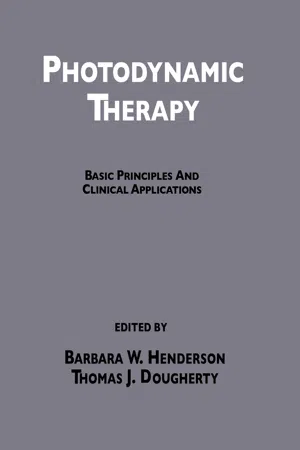
Photodynamic Therapy
Basic Principles and Clinical Applications
Barbara W. Henderson
- 480 pages
- English
- ePUB (mobile friendly)
- Available on iOS & Android
Photodynamic Therapy
Basic Principles and Clinical Applications
Barbara W. Henderson
About This Book
Covering all aspects of photodynamic therapy, 70 expert contributors from the fields of photochemistry, photobiology, photophysics, pharmacology, oncology and surgery, provide multidisciplinary discussions on photodynamic therapy - a rapidly-developing approach to the treatment of solid tumours.;Photodynamic Therapy: Basic Principles and Clinical Applications describes the molecular and cellular effects of photodynamic treatment; elucidates the complex events leading to photodynamics tissue destruction, particularly vascular and inflammatory responses; discusses the principles of light penetration through tissues and optical dosimetry; examines photosensitizer pharmacology and delivery systems; reviews in detail photosensitizer structure-activity relationships; illustrates novel devices that aid light dosimetry and fluorescence detection; and extensively delineates clinical applications, including early diagnosis and treatment.;A comprehensive and up-to-date reference, this book should be useful for oncologists, pharmacologists, surgeons, photobiologists, optical engineers, laser technicians, biologists, physicists, chemists and biochemists involved in cancer research, as well as graduate-level students in these disciplines.
Frequently asked questions
Information
1
Historical Perspective
I. Samuel Schwartz
Embryonic Days | The 1930s |
C. J. Watson Laboratories, University of Minnesota, 1934 | |
Porphyrins, porphyrias, poetry, photosensitivity | |
Fetal Days | The 1940s |
Manhattan Project, University of Chicago | |
Ionizing Radiations | Effects |
1. Define | |
2. Prevent | Porphyrin, protect, potentiate? |
3. Take Advantage of (shared effects of light and X-rays) | |
Infancy | The 1950s |
Hematoporphyrin (HP) | |
Variable commercial products | |
Variable tumor localization | Cancer—porphyrin uptake? |
Fractionate or make “derivatives” | |
(Urethane, HOAc/H2SO4, etc.) | |
The 1950s | Therapy trials |
HP plus X-irradiation | |
A. Subjects | B. Materials |
1. Humans (1955, inoperable CA) | 1. Free porphyrins (many sources) |
2. Mice | 2. Metal complexes |
3. Dogs | |
4. Paramecia | |
5. Enzymes |
- The dose dependency of radiation response in transplanted rhabdomyosarcoma tumors in mice was shown most strikingly in studies with Cohen [6]. About 2300 R was delivered to tumors transplanted to thighs of 153 mice. Three hours earlier the mice had been injected intraperitoneally with bicarbonate vehicle alone or with 10, 50, 250, or 1250 μg of a crude hematoporphyrin or its copper complex (the copper complex does not fluoresce, and is not photosensitizing). Results with both materials were similar and have been pooled. One hundred percent cures (27 of 27 mice) followed injection of 50 μg of either porphyrin preparation; only three cures were found in the remaining 126 mice during the 84- to 86-day study. The lowest dose, 10 μg/mouse, significantly improved tumor regression and mouse survival, but not enough to yield cures. I might also note that the optimum dose f...
Table of contents
- Cover
- Half Title
- Title Page
- Copyright Page
- Preface
- Introduction
- Contents
- Contributor
- 1 Historical Perspective
- I Molecular and Cellular Effects of Photodynamic Therapy
- II Tissue Effects of Photodynamic Therapy
- III Clinical Applications of Photodynamic Therapy
- IV Photophysics and Photodynamic Therapy Technology
- Index
- About the Editors